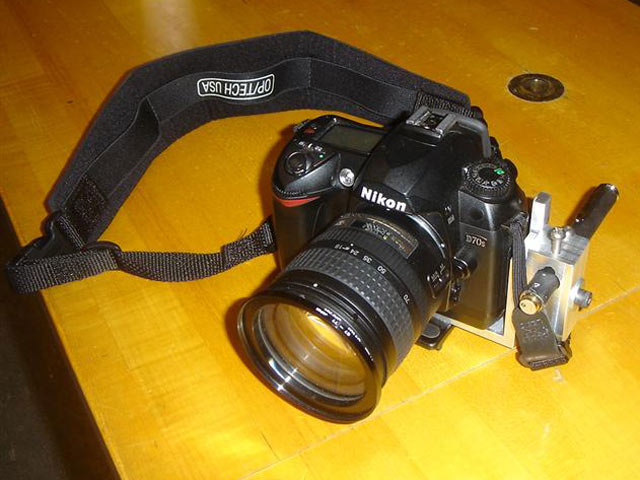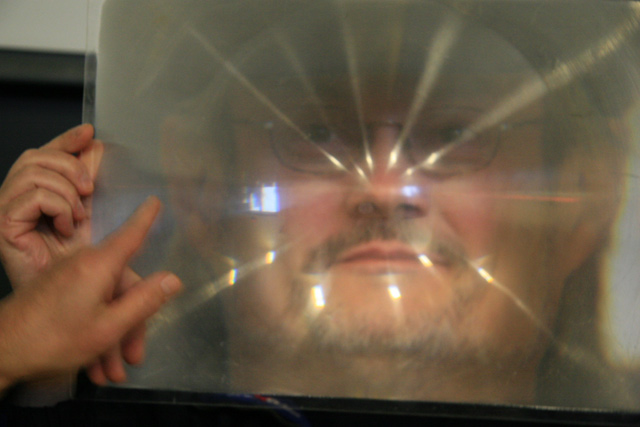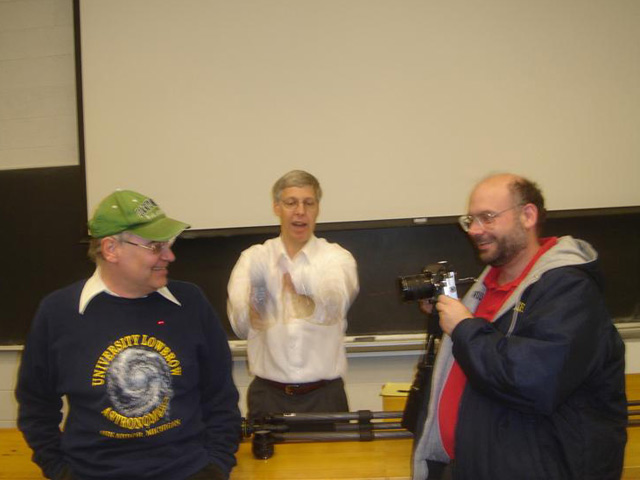

This fall, we had another term of Saturday Morning Physics, this time there were a variety of topics: Photography, Lighthouses, History of Astronomy, Tissue Engineering, Mammoths/Mastodons. I'll briefly discuss some of these topics.
Brad Orr (Professor of Applied Physics at UM) gave a set of talks on photography. He started by discussing camera lenses; how they work, and some of associated distortions. He then talked about exposure and explained how to get the right exposure: you need to balance shutter speed, aperture and film speed.
Among other things, Brad showed that for hand held photography under typical conditions, the shutter speed (measured in seconds) always must be less than one over the focal length of the camera lens (measured in millimeters). So for a 50mm lens, you need a shutter speed less than 1/50 second. Otherwise you will get a blurry image.

To demonstrate this, Brad mounted a small red laser on the side of a camera (see photo above, the laser is on the right). He pointed the camera at the wall; the image of the red laser was visible and it seemed to vibrate within a small area. This showed that Brad at least couldn’t hold the camera steady. (No one else can either). From experiments like this, we can quantify the extent of these involuntary hand motions and derive the relationship between focal length and shutter speed.
John Causland was intrigued by this, and thought that this might be modified into a “point and shoot camera” for astrophotography.
In most cases professional photographers use tripods to hold cameras steady. Brad did not discuss astrophotography, but mounting the camera to a telescope or on a tripod is essential for most astrophotography since normally the shutter speed will be longer than the maximum for a hand-held shot.
Brad discussed a few other topics including automatic focusing, digital cameras and the properties of light.
James Woodward (Lampist, The Lighthouse Consultant, LLC) gave a set of talks on lighthouses. Mr. Woodward starting with campfires lit on a beach; prehistoric people used the campfires to find their way home. Mr. Woodward described such fires as the first lighthouses. He described a number of improvements, including the Fresnel lens. The Fresnel lens was developed in the early 1800’s and allows most of the light from a burning lamp or electric bulb to be sent in a horizontal beam (not as focused as a laser, but focused enough to produce a bright point of light visible a few miles from shore). A Fresnel lens is a complicated assembly with many pieces of glass mounted on a frame. The materials used to mount the glass break down in UV light and were a maintenance headache. They are not great at forming an image, but are a relatively inexpensive way to make a large lens.
He also discussed more recent innovations. The beam from modern lighthouses (from 1800’s onward) rotate. As the speed of ships increased, it became necessary to increase the rotation speed. Before the invention of the ball bearing, this was difficult to accomplish. The idea of floating the Fresnel lens and bulb on a pool of mercury was developed. This worked well, however there were a couple problems. The fact that mercury was toxic has been known for a long time, and it certainly was known at the time, but mercury’s use was not well regulated until more recent times. Some workers and other people near the mercury pool occasionally got sick. Secondly, mercury vapor interacts chemically with other metals, including steel, resulting in corrosion. Over time, this caused significant problems in some cases.
Many old mercury lighthouses have been converted to use a system using ball bearings to rotate the lamp. This removes mercury and the problems associated with mercury.

After World War II, it became possible to manufacture Fresenel lens with a single piece of plastic. This reduced both production and maintenance costs. Charlie Nielsen (above) shows a plastic Fresnel lens.
Owen Gingerich (Professor Emeritus of Astronomy and History of Science, Harvard) gave a presentation entitled “Four Myths of the Copernican Revolution.”
As you might guess from the title, Dr. Gingerich presented four myths and explained why they are not true (to prepare this article, I borrowed some of Dick Sider’s notes).
1) Pre-Copernican models used epicycles. There were so many epicycles, that the system collapsed because it was too complicated. Copernicus solved this problem.
Not true. Pre-copernican models used only one epicycle per planet (and one for the sun and one for the moon). It was slightly inaccurate, but that didn’t seem to bother anyone until the time of Tycho Brahe. And no one thought it was too complicated. The Copernican system also had epicycles, again one per planet. So it didn’t solve the problem of epicycles.
2) Copernicus’ system greatly improved the accuracy of predicting the positions of the planets.
Not true. Since Copernicus assumed that the orbits were circular, his system had roughly the same accuracy as previous systems.
3) Tycho Brahe had daily records of the position of Mars. Kepler used those records to deduce that the orbit of Mars was an ellipse.
It’s an oversimplification to say Tycho was only interested in collecting data and Kepler was only interested in theory. Tycho had a number of ideas, and to test these ideas he collected position measurements of Mars, but not daily; rather he collected this data primarily along key sections of the orbit. Tycho’s data on Mars and other objects was much more accurate than anything previously collected. Because of this increased accuracy, the errors caused by using circular orbits could no longer be ignored. Tycho wanted to solve this problem himself, but after some delay he finally gave his Mars data to Kepler. Kepler’s task would have been easier with daily observations, but he was able to use the data he had to deduce that the orbit of Mars was an ellipse.
4) Galileo’s observations proved that the earth and the other planets orbited the sun.
Not true. Galileo showed that there were four moons orbiting Jupiter, but none of his observations proved anything one way or the other for the question: do the planets orbit the sun? Such a proof would wait for the work of Newton.
I’ve presented only a very brief outline of what was discussed during these lectures, if you want more details go to http://www.lsa.umich.edu/physics/events/saturdaymorningphysics/pastevents
There will be another set of talks starting in February. Most of the talks are on astrophysics or cosmology. The schedule can be found at http://www.lsa.umich.edu/physics/events/saturdaymorningphysics

The photos on this page were taken by John Causland and Mike Radwick.